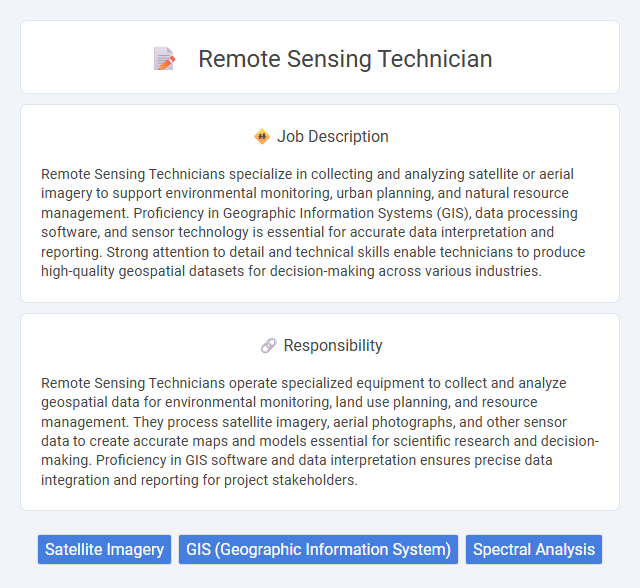
Remote Sensing Technicians specialize in collecting and analyzing satellite or aerial imagery to support environmental monitoring, urban planning, and natural resource management. Proficiency in Geographic Information Systems (GIS), data processing software, and sensor technology is essential for accurate data interpretation and reporting. Strong attention to detail and technical skills enable technicians to produce high-quality geospatial datasets for decision-making across various industries.
Remote Sensing Technician roles might suit individuals who are detail-oriented, enjoy working with technology, and have strong analytical skills. People comfortable with data interpretation and long periods of screen time could find this job compatible with their strengths. Those less adept at technical tasks or preferring more physically active roles may find the position less suitable.
Qualification
A Remote Sensing Technician requires proficiency in Geographic Information Systems (GIS), remote sensing software such as ENVI or ERDAS Imagine, and strong analytical skills for interpreting satellite and aerial imagery. A background in environmental science, geography, or a related field, often supported by a bachelor's degree, is essential. Certification in remote sensing or GIS technology and experience with data collection and processing enhance job qualifications.
Responsibility
Remote Sensing Technicians operate specialized equipment to collect and analyze geospatial data for environmental monitoring, land use planning, and resource management. They process satellite imagery, aerial photographs, and other sensor data to create accurate maps and models essential for scientific research and decision-making. Proficiency in GIS software and data interpretation ensures precise data integration and reporting for project stakeholders.
Benefit
Remote Sensing Technicians will likely benefit from increased demand as industries prioritize environmental monitoring and data analysis. They may experience enhanced career growth opportunities due to advancements in geospatial technology and growing applications in agriculture, defense, and urban planning. Competitive salaries and the potential for flexible, field-based work environments could also contribute to overall job satisfaction.
Challenge
Remote sensing technicians likely face challenges related to the interpretation of complex satellite and aerial data, where accuracy is critical for successful outcomes. They may encounter difficulties in managing large datasets and ensuring the precision of geospatial analysis under tight deadlines. Adaptability to rapidly evolving technologies and software updates could pose continuous learning demands in this role.
Career Advancement
A Remote Sensing Technician can advance their career by gaining expertise in data analysis software such as GIS and ENVI, leading to roles like Remote Sensing Analyst or GIS Specialist. Pursuing certifications in geospatial technologies and mastering drone operation enhances job prospects and salary potential. Experience with satellite imagery interpretation and project management often paves the way for senior positions within environmental consulting firms or government agencies.
Key Terms
Satellite Imagery
Remote Sensing Technicians specializing in satellite imagery analyze data captured by Earth observation satellites to monitor environmental changes, urban development, and natural resources. They utilize specialized software to process and interpret high-resolution images, ensuring accurate data extraction for scientific and commercial applications. Proficiency in Geographic Information Systems (GIS) and knowledge of multispectral and hyperspectral imagery significantly enhances their capability to deliver precise geospatial analytics.
GIS (Geographic Information System)
Remote Sensing Technicians specializing in Geographic Information Systems (GIS) utilize advanced spatial data analysis and satellite imagery interpretation to support environmental monitoring, urban planning, and resource management. Expertise in GIS software such as ArcGIS and QGIS enables efficient data integration, mapping, and geospatial modeling critical for decision-making processes. Proficiency in remote sensing technologies, including LiDAR and multispectral imaging, enhances accuracy in terrain analysis, land use classification, and change detection.
Spectral Analysis
Remote Sensing Technicians specializing in spectral analysis utilize advanced imaging technologies to collect and interpret data across various wavelengths, enabling precise identification of materials and environmental changes. They process and analyze spectral signatures captured by satellites, drones, or airborne sensors to support applications such as agriculture monitoring, mineral exploration, and environmental assessment. Expertise in software tools like ENVI and ERDAS Imagine enhances their ability to extract meaningful insights from complex spectral data sets.
 kuljobs.com
kuljobs.com